When one hears Nevada being mentioned, chances are the image of Las Vegas casinos pops into his mind. However, the state has a lot to offer nature lovers, too, as it has more mountain ranges than any other state. It’s also home to four national parks, and about 16 percent of its area is covered in forests.
Thanks to its diverse habitats, 490 bird species occur permanently or temporarily in the state, including our friends the owls! The spotted, barred, and snowy owls have been seen on rare occasions, but 10 species of these wise birds have wide ranges that include Nevada. We’ll tell you all about this impressive array of birds here!
Great Horned Owl

- Scientific Name: Bubo virginianus
- Length: 17-25 inches
- Weight: 32-88 ounces
- Wingspan: 3-5 feet
The great horned species is the largest owl in Nevada and North America as a whole. It sports mottled gray-brown plumage and horizontal bars on its underside. Despite the implications of its name, this species of bird doesn’t have horns. Instead, it has earlike tufts that make the already intimidating-looking bird look even scarier.
The owl’s body provides incredible camouflage as it perches among the trees waiting for its prey, but in the desert, it usually nests on cliffs. Great horned owls can also be seen in cities frequently.
The great horned owl has a diverse diet that includes both mammals and birds. In addition to going after other owls’ typical prey, this one feeds on house cats, ducks, other species of owls, hawks, and doves. Fun fact: it’s the only owl that feeds on skunks because it has a poor sense of smell.
Crows and songbirds usually harass the great horned owl by dive-bombing and even pecking at it.
Long-Eared Owl

- Scientific Name: Asio otus
- Length: 12-16 inches
- Weight: 7.8-15.3 ounces
- Wingspan: 34-40 inches
The long-eared owl is rather common in Nevada, and birds of this species are usually found in mixed forests near grassland and pasture areas. You’ll know it by its slender black-buff body, dark face, and long ear tufts. Its camouflage makes the process of locating this owl more difficult. Hearing it, on the other hand, is easy thanks to its long hoot.
This owl mainly feeds on mammals, including voles and mice. But in some cases, it catches birds from the ground or low vegetation. In most cases, the long-eared owl kills its prey by a bite at the back of the skull, followed by swallowing the prey as a whole.
The long-eared owl’s auditory system is highly developed, increasing its chances of locating and hunting prey in total darkness. It uses the abandoned stick nests of other birds, including the black-billed magpies, common ravens, and American crows.
Short-Eared Owl
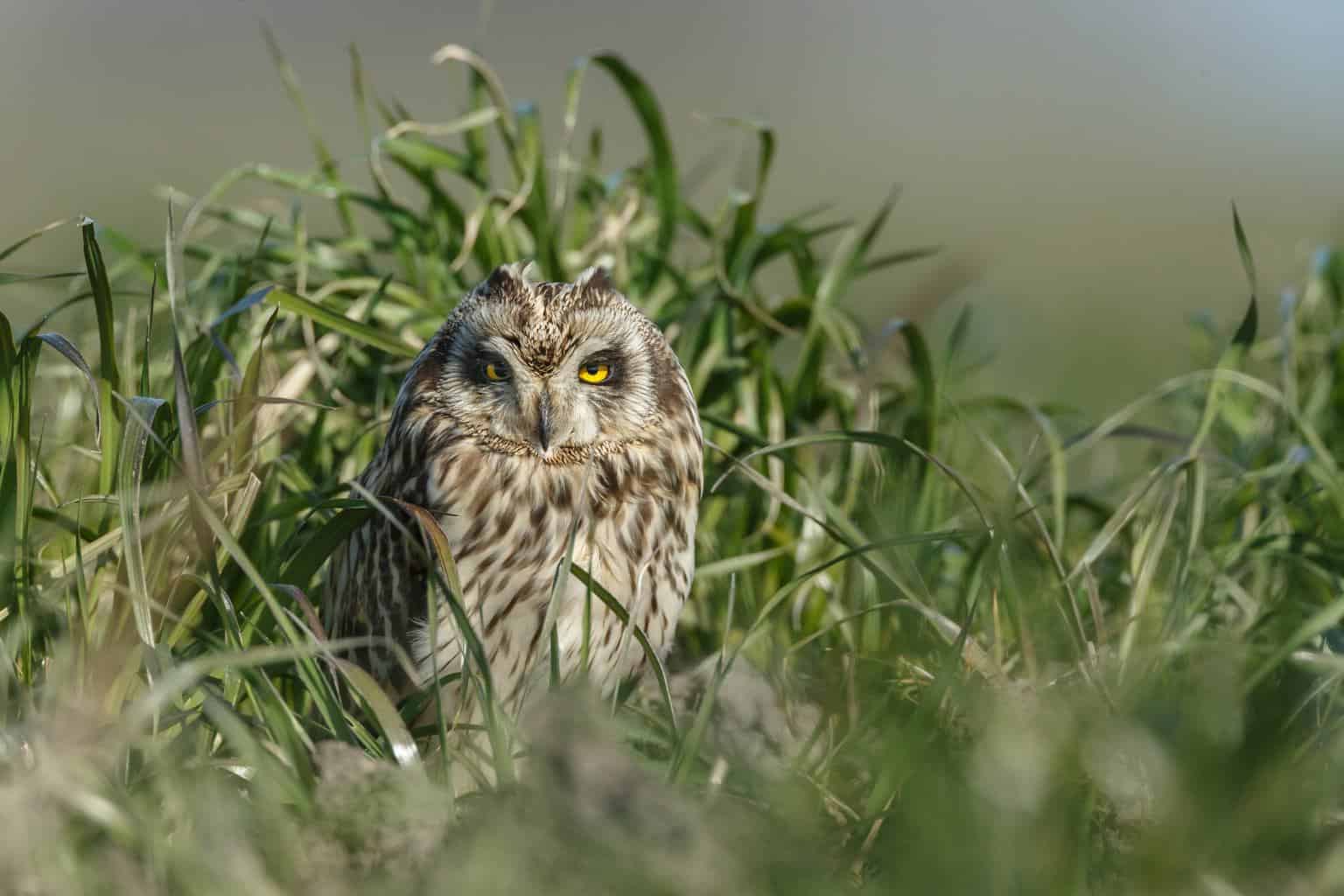
- Scientific Name: Asio flammeus
- Length: 13-17 inches
- Weight: 7.3-16.8 ounces
- Wingspan: 33-43 inches
The short-eared owl is an all-year resident of the western areas of Nevada. But during the winter months, the bird travels to other areas, including prairies, meadows, and marshes. Look for its medium-sized brown spotted body and almost invisible ear tufts.
There are several differences between the short and long-eared owls, starting with the plumage that looks more orangey on long-eared owls. Both species also have different beak colors, calls, and habitat preferences.
This species prefers low light conditions, but during the breeding season, it stays active all day. It feeds on voles and mice, and it might also eat songbirds. Unlike most owls, it builds its own nest instead of recycling one that was abandoned by another bird.
Short-eared owls perch on low trees and spend their time on the ground. Seeing them may be a bit difficult, however, as developmental projects have caused a decline in this owl population.
Western Screech-Owl

- Scientific Name: Megascops kennicottii
- Length: 8.7 inches
- Weight: 5 ounces
- Wingspan: 22 inches
The western screech-owl species has a wide range, stretching from Alaska to Central America, so it’s not surprising that the bird can be found in Nevada year-round. It has a small grey or brown body and ear tufts. If you hope to attract a breeding pair to your backyard, offer them a nesting box.
Western screech-owls look for either naturally occurring cavities or those that were excavated by woodpeckers. Sometimes, though, they take over the nests of other species.
This owl is rather shy and presses its body against the tree bark at its cavity entrance to camouflage. Due to the birds’ nocturnal habits and more reserved nature, they’re usually difficult to see.
When it’s time for a meal, western screech-owls feed on mammals, insects, and invertebrates and usually avoid areas where the great horned owl is present.
Burrowing Owl

- Scientific Name: Athene cunicularia
- Length: 7.5-11 inches
- Weight: 4.9-8.5 ounces
- Wingspan: 20-24 inches
The sand-colored burrowing owl has a small head and cream feathers on its belly. You’ll find this species living in open dry areas and deserts, usually associating with burrowing animals.
The owl mainly lives in burrows excavated by the prairie dog, badgers, or ground squirrels. These holes are extra beneficial because they protect young birds well.
Burrowing owls are crepuscular, though they can be seen hunting all day long. They feed on invertebrates and small vertebrates, like lizards, birds, mammals, and insects. During the day, females catch more insects while males catch mammals at night.
You may find a bird of this species nesting in underground man-made structures hiding from its primary predators — larger owls, hawks, cats, dogs, and weasels.
Barn Owl

- Scientific Name: Tyto alba
- Length: 13-15 inches
- Weight: 14.1-24.7 ounces
- Wingspan: 31-37 inches
In Nevada, barn owls can be found on the outskirts of towns. It’s one of the most widespread owls in the world, though it doesn’t fit the definition of a true owl.
The nocturnal bird of prey has a ghostly look with pale buff and grey feathers. It doesn’t hoot like other owls, staying silent most of the time, but its call of communication is a long and unsettling scream that annoys most people.
The barn owl hunts mammals that are active by night, like mice and voles. It stores prey in tree cavities until the eggs hatch, and these birds build their nests in cliff ledges and tree cavities, usually using shredded pellets.
Northern Pygmy-Owl
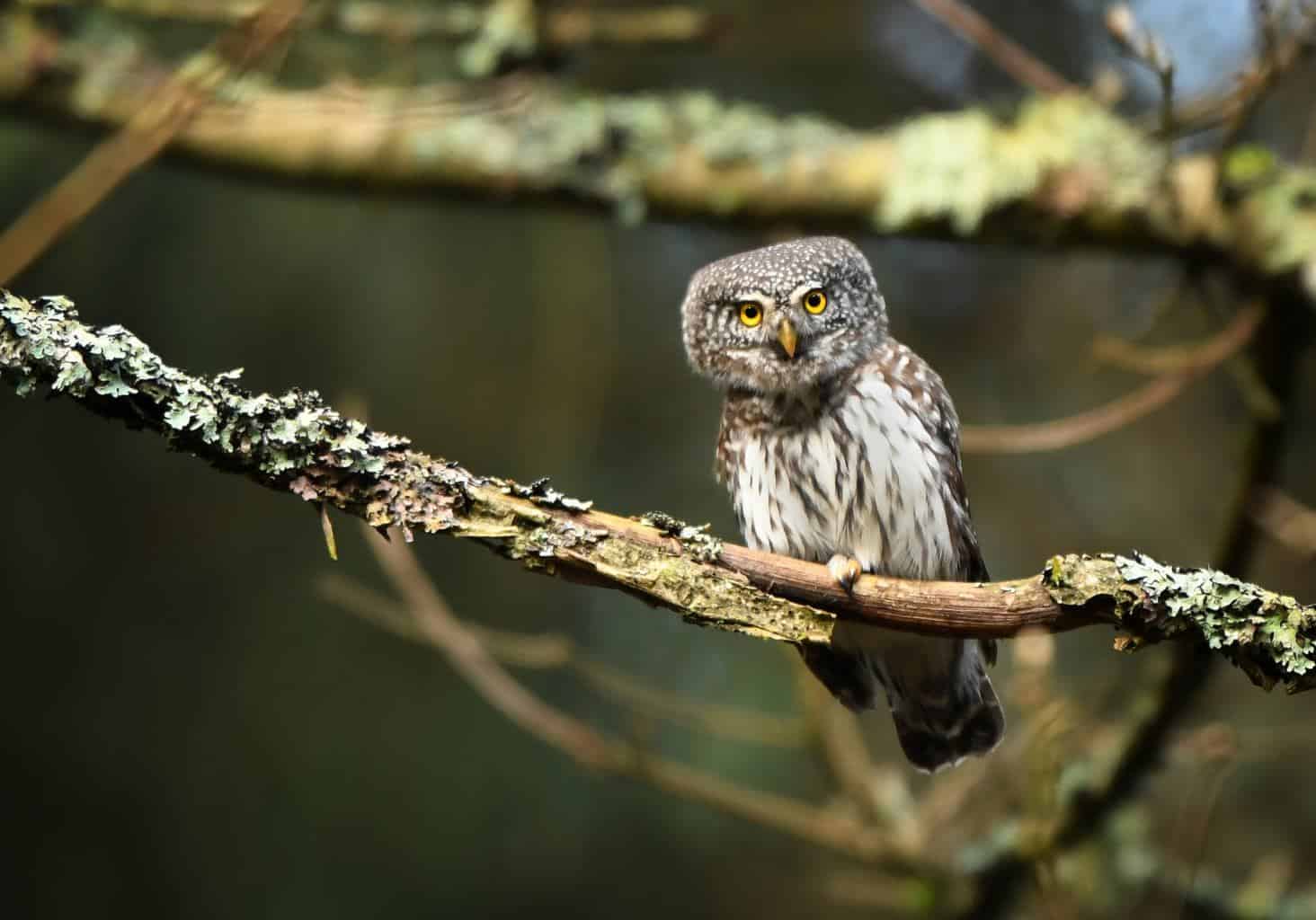
- Scientific Name: Glaucidium californicum
- Length: 6.3-7.1 inches
- Weight: 2.1-2.5 ounces
- Wingspan: 16 inches
The northern pygmy-owl has a small brown body and white spots, and the two patches on the back of the bird’s head mimic the look of its eyes. Catch them spending their days in coniferous forests.
This owl mainly eats small birds like hummingbirds, sparrows, and chickadees, as well as a small mammal or two from time to time. It sometimes even attacks animals that are larger than it is!
Northern pygmy-owls don’t build their own nests. Instead, they rely on cavities excavated by woodpeckers. They hunt by day and usually aren’t as difficult to find as other owls are. Unfortunately, breeding pygmy-owls don’t accept nesting boxes.
This species’ natural predators include larger owls and raptors, plus big mammals like weasels. Hummingbirds, wrens, and creepers usually mob the northern pygmy-owl. Because these owls are uncommon, it’s pretty difficult to count the species’ population.
Northern Saw-Whet Owl
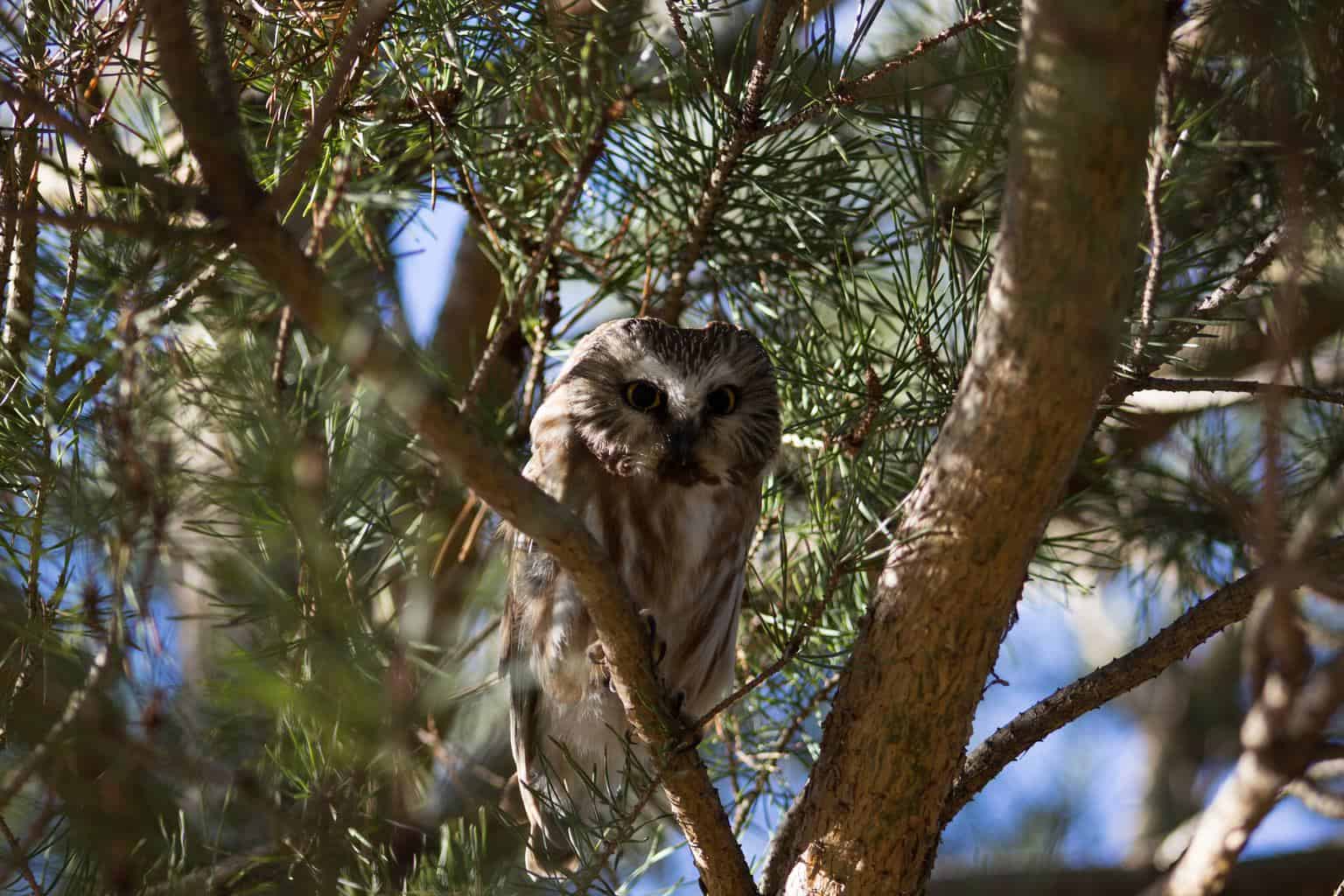
- Scientific Name: Aegolius acadicus
- Length: 6.7-8.7 inches
- Weight: 1.9-5.3 ounces
- Wingspan: 16.5-22.2 inches
In Nevada, the northern saw-whet owl is likely to be found in densely wooded areas. This small owl has a mottled brown body and yellow eyes, and despite its shyness, the nocturnal bird has a rather wide range.
This species feeds on small mammals like voles, shrews, and white-footed mice, but when it migrates, it supplements its diet with small songbirds.
Northern saw-whet couples are usually monogamous, but the male is likely to mate with more than one female during a mating season when prey is abundant.
This owl is subject to mobbing by mixed songbirds, and it’s preyed upon by larger raptors, including the great horned owl, peregrine falcon, and Cooper’s hawk.
Elf Owl
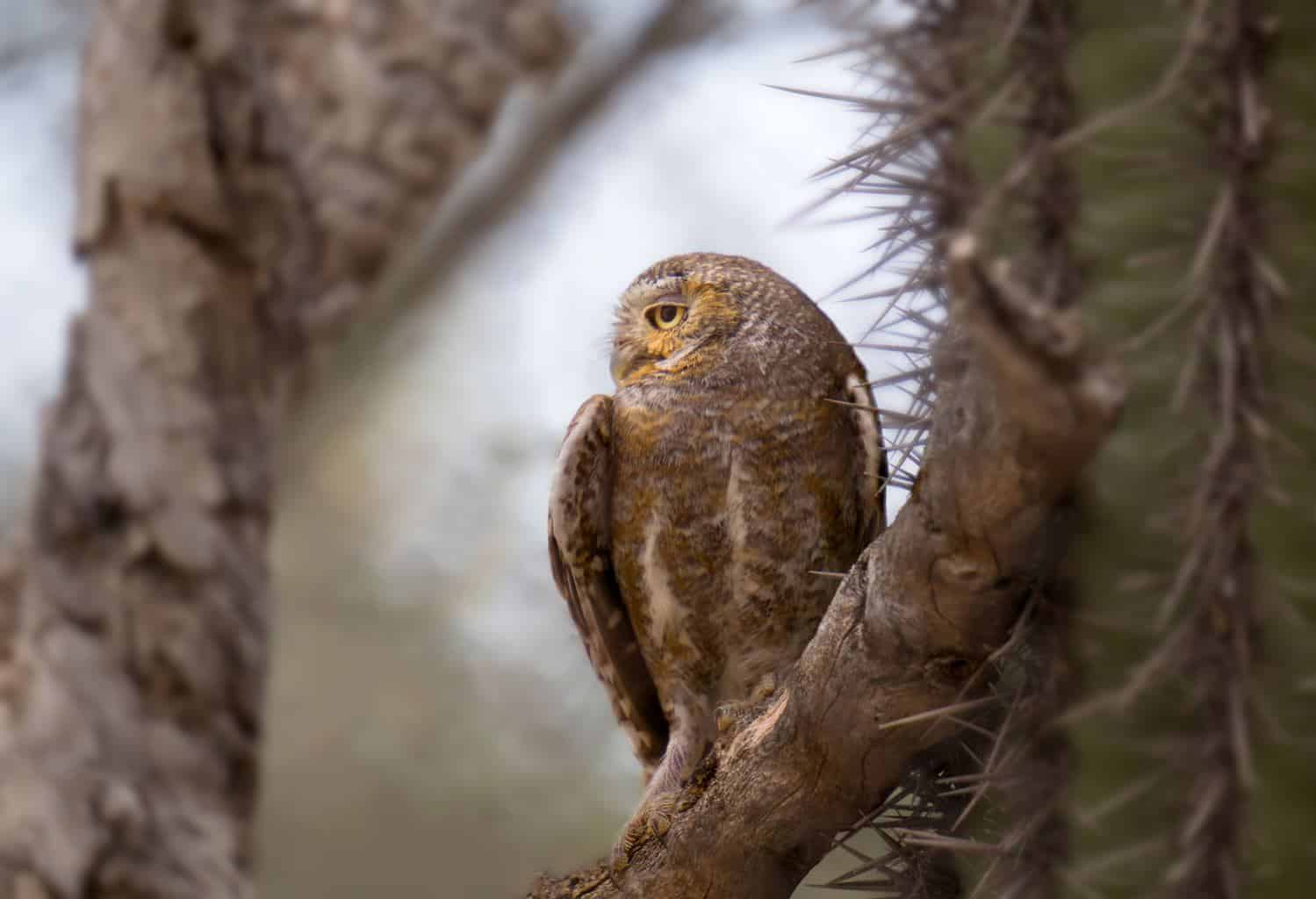
- Scientific Name: Micrathene whitneyi
- Length: 4.9-5.7 inches
- Weight: 1.4 ounces
- Wingspan: 10.5 inches
The elf owl is the world’s smallest owl and can usually be found in tree cavities caused by rot or excavated by woodpeckers. It has greyish-brown feathers and yellow eyes, and in Nevada, the elf owl is usually found along the state’s southern borders.
Though it has good vision and low light conditions, the elf owl usually depends on its hearing to pinpoint the location of its prey. The nocturnal bird flies silently, thanks to the softened feathers on the wings’ edges.
Elf owls feed on invertebrates like moths, scorpions, and crickets, and unlike most owls, this one usually plays dead when it faces danger. Its predators include other larger owls, bobcats, snakes, and coyotes.
During the winter, the migratory owl travels south.
Flammulated Owl
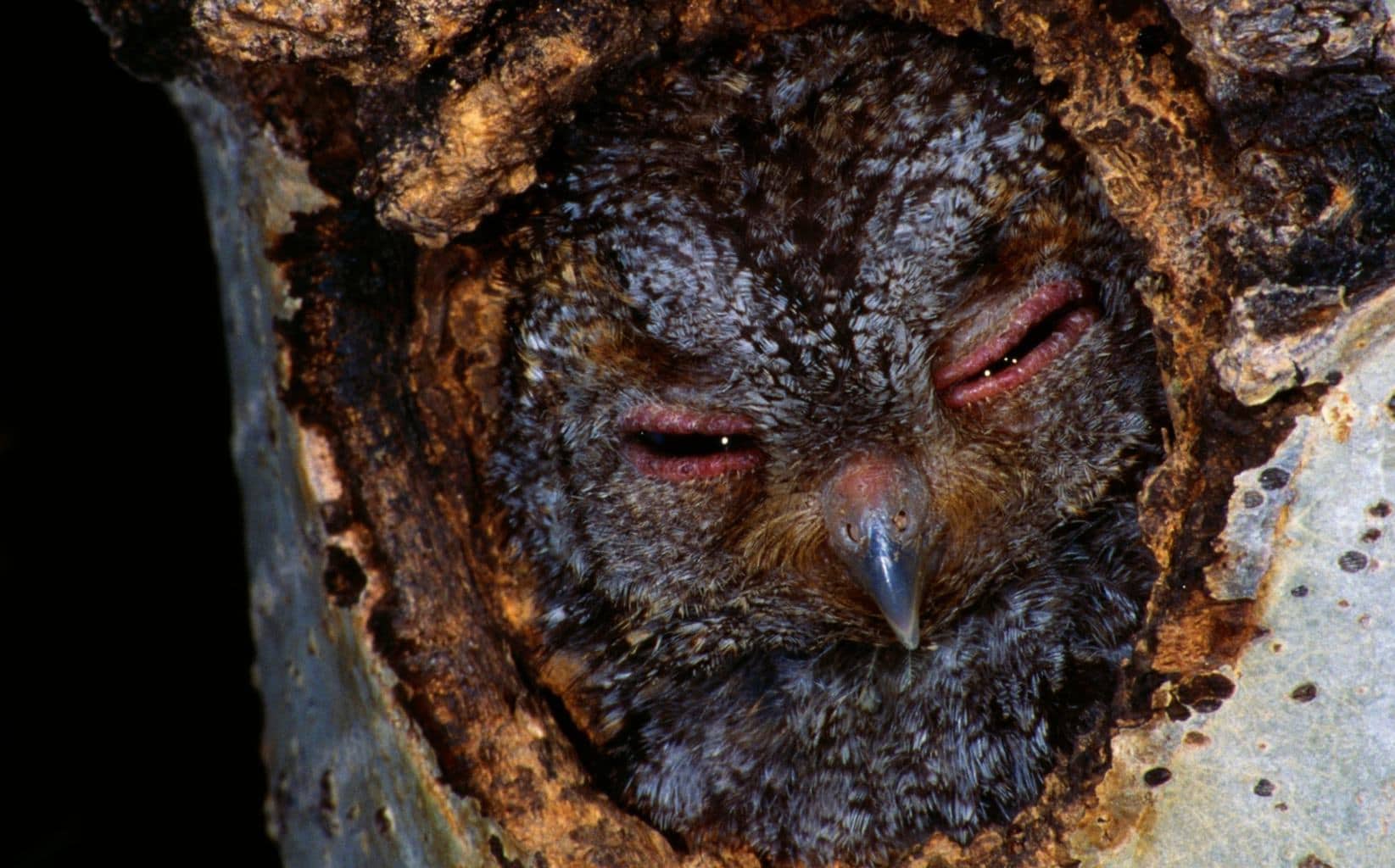
- Scientific Name: Psiloscops flammeolus
- Length: 6 inches
- Weight: 1.8-2.3 ounces
- Wingspan: 14 inches
Much like the elf owl, the flammulated owl feeds on insects and travels south where prey is more abundant. This species of owls have greyish-brown or rusty feathers with white spots to create the perfect camouflage.
To many birders, the owl looks like a smaller, tuft-less version of the western screech-owl, and the flammulated owl mainly feeds on insects like crickets, owlet moths, bugs, and beetles. You’ll find it hunting by night.
These owls depend on other birds, like the pileated woodpecker or northern flicker, to create cavities in dry mountain forests. This owl has a large windpipe that makes it sound like a much larger bird, and thanks to its low hoot, you just might be able to find one.
Wrap Up
The best way to locate owls in Nevada — or anywhere, really — is to look for pellets or research to find the species’ favorite prey. Nevertheless, even if you miss out on seeing an owl, you’ll definitely get a chance to watch a wide variety of wonderful birds in the state.

